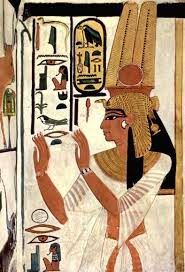Cleopatra Rules! by Vicky Alvear Shecter is a biography about the famous Egyptian Queen Cleopatra. It uses current teen vocabulary to relate to audiences about ancient history regarding Cleopatra, Caesar, Mark Antony, Octavian, and other great rulers from Egyptian and Roman times. This fun yet informational text spans over Cleopatra's life from childhood to her tragic death. Using photographs, artistic depictions, and works from the actual time, the images help to give readers an idea of what life looked like during Cleopatra's existence.
 Cleopatra Rules! is an excellent children friendly biography, connecting with young audiences. It differs in the usual form of biographies, straying from using text that resembles the time period. Shecter does succeed immensely when portraying Cleopatra authentically and accurately. She tells about the ups and downs of Cleopatra's life, not leaving out the gory and unpleasant arts. They are told in way that, I believe, is understood by children without being overtly violent or grotesque. I even learned a thing or two about the Queen and Egyptian history.
Cleopatra Rules! is an excellent children friendly biography, connecting with young audiences. It differs in the usual form of biographies, straying from using text that resembles the time period. Shecter does succeed immensely when portraying Cleopatra authentically and accurately. She tells about the ups and downs of Cleopatra's life, not leaving out the gory and unpleasant arts. They are told in way that, I believe, is understood by children without being overtly violent or grotesque. I even learned a thing or two about the Queen and Egyptian history.This book is full of content while still being hip and engaging to the reader. Even the cover is appealing to young audiences, referring to Cleopatra has the "original teen queen." While including photos from Hollywood films of famous actresses who have portrayed Cleopatra in the past, I would imagine that it is appealing and attractive to specifically teenage females. I also find that learning about Cleopatra's history in an accurate manner can be good for young women. She is described by Shecter has powerful, strong, and resilient with massive amounts of charisma.
Shecter also addresses the topics of Cleopatra's romantic relationships, affairs, and legendary beauty. She explains that no one knows for sure if she was as beautiful as it has been said but that it wasn't really important. She was a fierce leader with the brains and gumption to back it up. This also is a good message for young audiences, especially female.
Biographies are crucial for children readers because knowing one's past is what takes one into the future. Discovering the truth about legends and heroic figures gives children hope, inspiration, and drive to live their lives to the fullest. Stories do not always end in happily ever after but there is good that can come from negative experience.
Motivational activities:
*After reading about Cleopatra, show the class a couple chosen scenes from a few Hollywood films that depict Cleopatra. Then, have students discuss what they believe to have been accurate and inaccurate. Have them present their answers to the class.
*Cleopatra was a strong leader in her time. Have students make a list of some of Cleopatra's strongest attributes. Then have them list some of what they believe to be their strongest attributes. Have them explain how these traits may be useful to them in their daily lives.
Reader Response Questions:
1. How many times did Cleopatra marry and how many children did she have?
2. Name one of Cleopatra's triumphs as a ruler. Describe this victory and explain how it happened.
3. Cleopatra suffered a tragic death. Describe how she died.
Further reading:
*I Am #10: Cleopatra by Grace Norwich
*You Wouldn't Want To Be Cleopatra!: An Egyptian Ruler You'd Rather Not Be by Jim Pipe
*Who Was Leonardo da Vinci? by Roberta Edwards and True Kelley
*Queen Eleanor: Independent Spirit of the Medieval World by Polly Schoyer Brooks
*Sterling Biographies®: Cleopatra: Egypt's Last and Greatest Queen by Susan Blackaby


_06.jpg)


Dawn,
ReplyDeleteYour blog is very informative on all genres of Children's literature! I enjoyed your Blog on Cleopatra. Also, you provided an engaging lesson following the book. Here is another lesson that would work as well:
Lesson plan for 4th grade on “Cleopatra” and Ancient Egypt civilizations:
1. Explain events, ideas, or concepts in a historical, scientific, or technical text, including what happened and why, based on specific information in the text.
Watch BrainPop movie on Ancient Egypt and follow up with response questions:
Link to movie-
http://www.brainpopjr.com/socialstudies/ancienthistory/ancientegypt/
(Most schools or teacher have access codes for BrainPop educational site)
*Fun fact
Discuss that Cleopatra was the last pharaoh in Ancient Egypt times
Response Questions:
a. What do you think a pharaoh is?
b. Who knows where the pharaohs lived during this time?
*Teacher response:
Let the class know that Cleopatra is an important part of Ancient Egyptian history and that they will be studying where pharaohs lived thousands of years ago.
2. Print, project onto the whiteboard, or make your own KWL chart from the Talk About It feature. Ask students what they know about Ancient Egypt already. They may bring up Mummies, King Tut, or the Pyramids. Ask them to elaborate as much as possible on any of the topics and fill in the first column of the chart (What do you know about Ancient Egypt?) as they discuss. Then ask them about what they'd like to know as you fill in the second column (What do you want to know about Ancient Egypt?). Save the KWL chart for later discussion.)
3. Make a word wall with key text words- Review vocabulary
Pharaoh Ruins
Artifact Hieroglyphics
4. Quiz on vocabulary and multiple choice questions about Ancient Egypt
For reference:
http://www.brainpopjr.com/socialstudies/ancienthistory/ancientegypt/